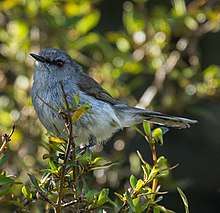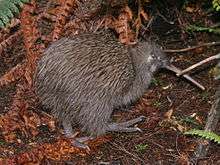Grey warbler
| Grey warbler | |
|---|---|
 | |
| Scientific classification | |
| Kingdom: | Animalia |
| Phylum: | Chordata |
| Class: | Aves |
| Order: | Passeriformes |
| Family: | Acanthizidae |
| Genus: | Gerygone |
| Species: | G. igata |
| Binomial name | |
| Gerygone igata | |
| Synonyms | |
| |
The grey warbler (Gerygone igata), also known by its Māori name riroriro[2] or outside New Zealand as the grey gerygone, is an insectivorous bird in the family Acanthizidae endemic to New Zealand. Its natural habitat is temperate forests. It is sometimes known as the teetotum or rainbird.[3]
Description
One of the smallest birds found in New Zealand, grey warblers are about 11 centimeters long, with a weight of up to 6.5 grams.[3] It has grey-brown plumage (with a slight olive-green tint), with the face, throat and breast being pale-grey. The abdomen is off-white with a slight yellow tinge. The tail is white underneath and dark brown on top with white tips being visible in flight. They also have a distinctive ruby-red eye. Females are typically smaller than the male, but otherwise there is little sexual dimorphism. The young are paler with no hint of yellow and have brown eyes.
The male's song often starts with a series of three squeaks and builds into a distinctive long plaintive wavering trill that rises and falls. They sing throughout the year but most vigorously when nesting, during spring. Grey warblers are often heard more than they are seen.
Distribution and habitat
Grey warblers are common throughout New Zealand's main islands and many off-shore islands, but are absent from open country and alpine areas. At home in native and exotic forests it may be found almost anywhere there is some tree or shrub cover.[4]
Behaviour
Diet
Grey warblers mainly feed upon spiders, insects and their larvae. They are very active, and almost never stay still as they move from one perch to another.
Nesting

Grey warblers are unique among New Zealand birds in building a pear-shaped nest with a side entrance near the top. The male collects nesting material, but the female builds the nest from grass, leaves, rootlets and moss, held together with spider web threads, anywhere from 2 to 25 feet above the ground, lined with feathers and other soft material. It is attached to a twig at the top, but is often also secured at the back or sides. The male is not involved in nest building or incubation, but helps to feed nestlings and fledglings. The 3 to 6 eggs, each laid 2 days apart, are pinkish-white with fine reddish-brown speckles all over. The eggs, weighing 1.5 grams are about 17 millimetres long and 12 millimetres wide. Incubation takes about 19 days and the chicks spend another 15 to 19 days in the nest.
Their breeding season is from August to January and they usually manage two clutches. The shining bronze cuckoo, a brood parasite, often targets the second clutch.[5]
References
- ↑ BirdLife International (2012). "Gerygone igata". IUCN Red List of Threatened Species. Version 2013.2. International Union for Conservation of Nature. Retrieved 26 November 2013.
- ↑ TPH 7/7/1905 p3 http://www.maoridictionary.co.nz/search?idiom=&phrase=&proverb=&loan=&keywords=Riroriro&search=
- 1 2 Grey warbler - New Zealand Birds Online http://nzbirdsonline.org.nz/species/grey-warbler
- ↑ Atlas Of Bird Distribution In New Zealand 1999–2004 - Ornithological Society of New Zealand http://notornis.osnz.org.nz/bird-distribution-atlas-1999-2004-last-gasp-field
- ↑ Davies, Nick (2010). Cuckoos, Cowbirds and Other Cheats. A&C Black. p. 94. ISBN 1408135868.
- NZ Royal Forest and Bird Protection Society, Nov 2003
- Gerygone Flaviventris. — (Grey Warbler.) | NZETC
| Wikimedia Commons has media related to Gerygone igata. |

